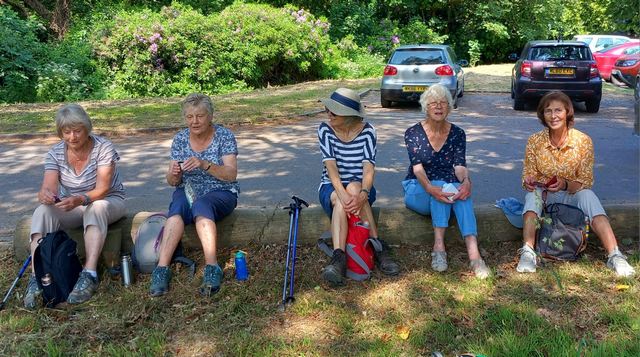Report of walk on Tuesday 28th November 2023
3+ mile walk around Deerpark Forest and Herodsfoot
It was a beautiful crisp dry autumn day with blue skies and little wind for 22 members of the walking group. Beginning at the Retreat Cafe at Forest Deerpark we followed a woodland walk until we reached the small village of Herodsfoot.
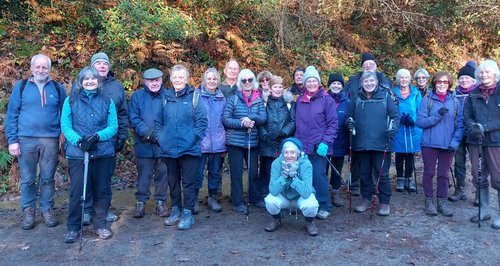
There has been a settlement here since medieval times and Herodsfoot is known as a 'thankful village'. In fact, Herodsfoot is one of only 14 villages in the UK which holds a very special claim of being a 'doubly thankful village' meaning that every single man who left to fight in the Great War (WW1) and every single man who left to fight in WW11, came home again.
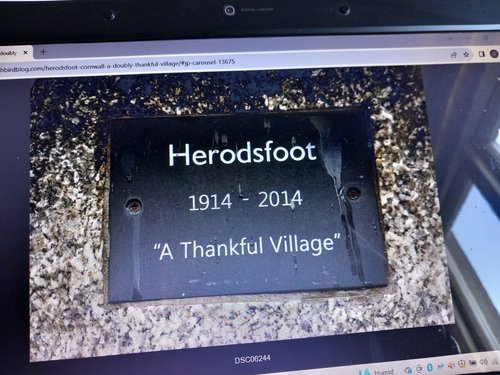
Your walk leaders on this occasion must apologise for not recognising that there were two styles on the second part of the walk and a tricky narrow path through the woods. We are sure you will understand that because of the dreadful weather in the weeks preceding the walk the planned recce had to be cancelled and the full walk was not completed. But not withstanding, most people seemed to thoroughly enjoy the morning, capped off by excellent service at the cafe who actually put on extra staff members to deal with us all. And gave local discount on our purchases too. Highly recommend this place for a short walk or even just a coffee.
Report on walk of Tuesday 14th November 2023
A 3-mile “Town and Country” circular walk around St Germans
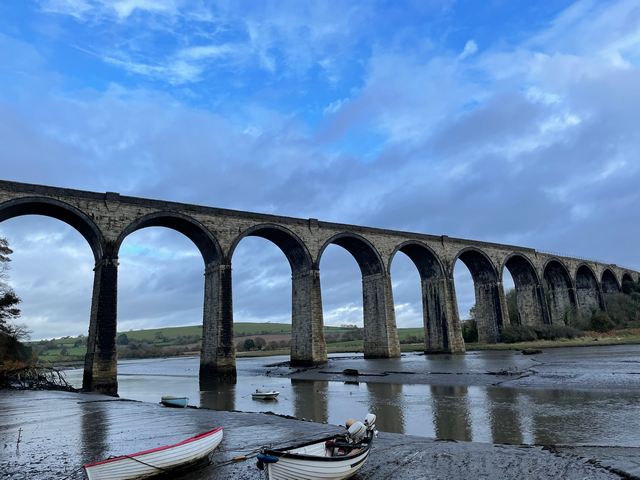
According to the weather forecasts (note the plural), the rain would stop at 11.00am and twenty walkers, including the walk leader, decided to join in the walk and their optimism was rewarded. In fact, we started the walk at 10.00 am and we did not see a drop of rain until we returned to our cars at about 1.30pm.
We had done this walk at least five years ago when we had had a pasty and cream tea lunch in Port Eliot, followed by a guided tour. This time, for the walk to end in the Port Eliot Stable Yard Café, we did the walk clockwise from the layby outside the Priory.
We made our way past a collection of buildings which at an earlier time was the Blue Anchor Public House. It became a grocer’s and shoemaker’s as well as The Post office. We saw the block of old police houses which were built at the same time as the railway station. St Germans station is one of the few in the southwest to retain its original buildings, the station being opened in May 1859 at the same time as the Cornwall Railway and the Royal Albert Bridge in Saltash. We walked down to the main quay from where we had excellent views of the viaduct and the estuary. A new quay was built in 1835 which, before the railway, was the main link between St Germans and the world outside, trading through Saltash, Devonport and Plymouth as well as Tideford upstream which could be reached by barge until 1950 – difficult to imagine as the river Lynher is so silted up now. The railway viaduct was built in 1908 to replace the old, largely wooden structure which had been a Brunel construction in 1859 and which the Earl had insisted should be painted white in order to “harmonise with the scenery in its vicinity”.

We walked away from the quay past some allotments with amazing views of the river, a playground and Fairfield House where surgeons and doctors lived in the 19th century. We walked out of the village through a field from where we had stunning views of the Lynher, walked back down into the village going under another viaduct and joined Well Lane in order to see the Almshouses, known as The Gallery, originally intended for 12 widows which received a shilling and a peck of barley at New Year. The Almshouses have been modernised and husbands may now stay with their wives.

We proceeded into Newport. This was the industrial part of the town in medieval days when pots and tiles were made in the kiln here. We walked past an old tannery and forge. Stable Yard at the end of Newport is a fine example of the work of Sir John Soane, as part of his redesigning of Port Eliot. It is being refurbished and includes a café and a gift shop, the café being one of the settings for the television series “Beyond Paradise”. As they are filming the Christmas episode, the Christmas tree and other decorations were up!
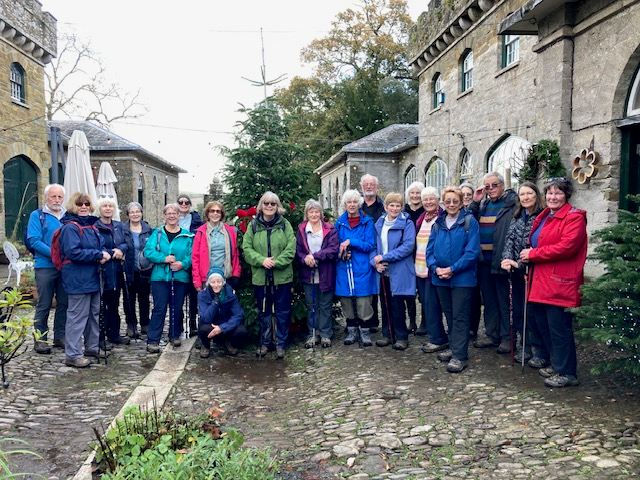
After a refreshment break, we made way back to our cars walking past Memorial Cottage, built in memory of the Eliot son and men of the Scots Greys killed in the First World War and occupied for a long time by the district nurse/midwife.
I wish I could say that the walk was without incidents, but it was not as the last two walkers lost sight of the group and went the wrong way. None of us had checked that nobody had been left behind, even though it is in our Risk Assessment! A learning curve for us all.
Report on walk of Tuesday 26th September 2023
Towan Beach – Portscatho – Porthcurnick

Ten members of our group met at the NT Porth Farm on the Roseland Peninsula for this walk which the group had never made.
We could not have chosen a better day for our walk. The weather forecast over the previous week had not always been very promising and the walk could even have been cancelled. In the end, we had glorious weather: sunshine, a gentle warm breeze and a calm sea.
We walked from Towan Beach to Porstcatho (2 miles) along the coast path and saw a seal diving in and out of the waves for a few minutes. We sat on the benches overlooking Portscatho harbour for our morning break and we enjoyed a slice of apple tray bake provided by Annie, our walk leader, which had recently celebrated her birthday. As it so happened there were 2 other September birthday ladies on the walk!
 |
 |
Portscatho is in Gerrans Bay on the Roseland peninsula. The East-facing cove affords shelter from the prevailing south-westerly winds and this meant it was ideal as a base for the pilchard fleets of the eighteenth and nineteenth centuries and is still, although on a much smaller scale, an active fishing port today. The same shelter makes for safe swimming and its proximity to many fine sandy beaches means it’s a family favourite.

Porthcurnick Beach is about half a mile away from Portscatho and this was our next destination for a picnic lunch. Most walkers had never been to the Hidden Hut which is situated above the beach now they know where it is and how to get to it.
Presided over by Jemma Glass and Simon Stallard, who took over the National Trust lease in 2010, The Hidden Hut is a beachside café like no other. Accessed only on foot via the coastal path between Portscatho and St Mawes, to the untrained eye, it looks more like a potting shed than a restaurant. But to those in the know and who can afford it, it’s home to popular lunch including seafood dishes. In the summer they hold weekly ‘feast nights’, to which diners bring their own wine, cutlery and crockery, and the tickets sell out within minutes. It has become what people describe a “Cult Café”. In 2021, Simon Stallard hauled his 50-foot barbeque from Porthcurnick beach over to Carbis Bay, a stone’s throw away from where that year’s G7 summit was held. Used to feeding throngs of hungry holidaymakers, on Saturday 12th July 2021, Simon was cooking for some of the world’s most powerful politicians, including President Biden and Prime Minister Boris Johnson.
Our return journey took us back along the coast path to Porstcatho and the intention was to return to the NT car park inland. At one point of our return journey as we arrived at a campsite, our walk leader (AND THIS IS A FIRST FOR HER!) confessed that she did not recognise where she was, even though she had done this walk twice recently. We decided to rejoin the coastpath. Our walk leader was very upset and cross with herself. We reassured her that walking back on the coast path was no hardship as it was such a beautiful day, and it was in fact a more picturesque route back.
We all indulged in an ice cream on our return to Porth Farm.
Report of walk on Tuesday 12th September 2023
Luxulyan Valley
It was a dry, slightly cooler day than late for the first outing of our Autumn/Winter programme, and 19 members of our walking group were keen to get out and savour a short but historically interesting circular walk from Ponts Mill car park to Black Hill car park. Most of us therefore walked a distance of not much more than 3 miles although one of our group did have to return afterwards to retrieve one walking boot and one sock left by mistake when he changed his shoes to return home. They were found by a concerned lady who worried they had been left by an unfortunate walker with only one leg. Our walker shall remain nameless - but you know who you are Chris!
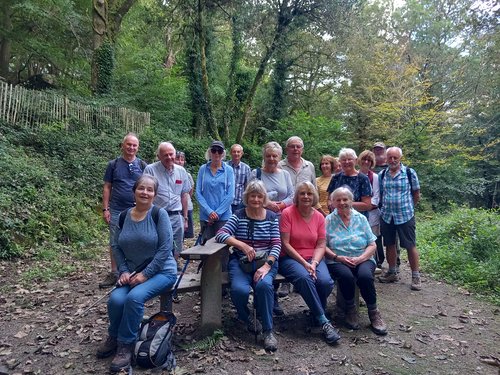
The path follows the Carmears and Fowey Consols leats passing the Wheel Pit, and Trevanney China Clay Kiln. Luxulyan Valley has long been regarded as an area of great outstanding beauty but also contains impressive remains of its industrial past. Up until 1730 the sea came up to Ponts Mill when vessels up to 80 tonnes berthed there.
In order for Joseph Thomas Treffry to promote his mining and quarrying interests in the early 1800s he needed to cross Luxulyan Valley which resulted in the construction of the imposing Treffry Viaduct, now managed under the auspices of Cornwall Heritage Trust. Later growing interest in the export of china stone and china clay brought about the building of Trevanney China Clay Kiln which operated from the 1920s to 1960s.
Since 2006 Luxulyan Valley has been part of the Cornwall and West Devon Mining Landscape World Heritage Site and is home to many varieties of wild life and flora and fauna. Sadly, on our walk, we saw none of the deer, otters or other animals promised in the guide book.
Report on walk of Tuesday 11th July 2023
St Veep to Lerryn
Fourteen members of our walking group made their way from Lostwithiel to St Veep Church via Lerryn for car sharing. There was no plan B so we all hoped that the weather would be kind to us and it was, apart for a very brief bout of drizzle past Haye Farm on the way down to Cliff. The sun made a very welcome appearance at the end of our walk when we were eating our lunch at the picnic tables on the village green.
From the Church, we walked into the field opposite where St Veep’s virgin peal of bells was cast in the mid-18th century. They are called virgin or maiden bells because their tune was perfect from the word go and nothing had to be adjusted in the freshly cast bells. It is the only peal of virgin bells in England. We eventually rejoined the road from Penpol to Haye Farm and walked up the moderately steep Hill past Haye Farm on the right and its cider orchards. Until recently, the author of The Salt Path and her husband rented the farmhouse.
At the top of the hill past Haye Farm, on the left-hand side, there are two gates side by side. Following the footpath sign, we walked through the right-hand gateway. We walked through two fields until we reached, on our right, a stile with stone steps over a wall and a waymarker.
We stopped to admire the views even thought they were partly obscured by the shower of drizzle. On the far left, on the opposite bank of the river Fowey, you see the village of Golant. Still on the opposite bank of the river but moving our gaze towards the right, on the foreshore at the bend of the river, is a small building constructed as a plunge pool and boat-house. It was built around the turn of the 20th century and reputedly visited by Edward VII when he was Prince of Wales. You see the river Lerryn as it flows into the river Fowey beneath St. Winnow point. Upstream you see St. Winnow Church and the Tudor Barton House tucked into the hillside near the water’s edge. Daphne du Maurier in her book “Vanishing Cornwall” makes the suggestion that this landscape may be the setting for the legend of Tristan and Iseult. Her theory is based on the supposition that Castle Dore, the ancient hill fort on the ridge above Golant, was the palace of King Mark, and that other place names also fit the legend.
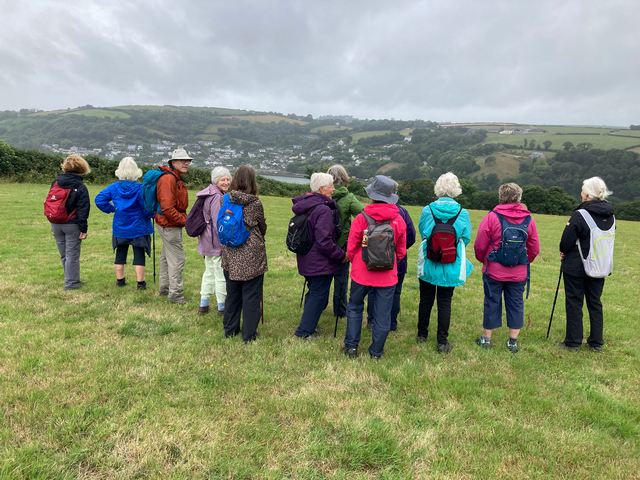
From there we made our way down to Cliff. King Charles I was here in August 1644. During the civil war, the parliamentary troops held the opposite shore and the King came here from Boconnoc to encourage his own troops. They were stationed at Cliff to guard the ancient ford which crossed the River Fowey. Do not try to find it today as the mud can be very dangerous. Cliff, at one time, was well known for its plum orchards and market gardens.
We walked up the lane for about 100 yards and on the left, in front of Penfoye House, followed a footpath which took you down to the foreshore, an ideal place for our coffee break especially as by now the weather had cleared. This footpath is probably the original track leading to the ford.
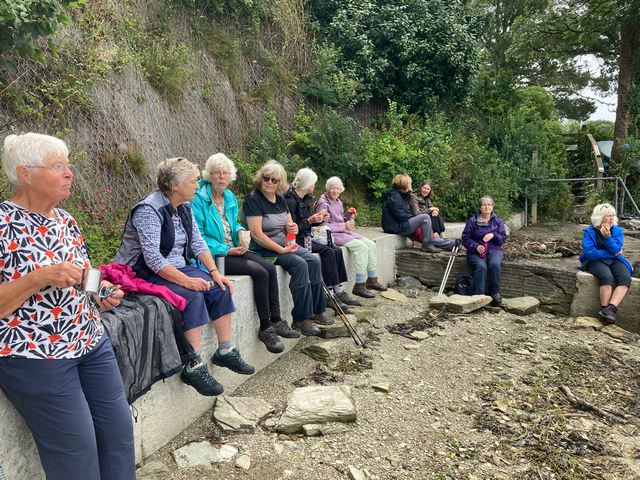
We retraced our steps, turned left into the lane, walked up the moderately steep hill until we reached the footpath sign on our left. This footpath took us to Lerryn through the woods. It is said that Kenneth Grahame, whilst walking these riverside paths from Lerryn to Cliff, was inspired to write ‘The Wind in the Willows’.
Back in Lerryn, we walked through Tivoli Park. Tivoli was a creation of Frank Parkyn, a successful china clay entrepreneur in Edwardian times. He lived in Lerryn and then across the River Fowey in Penquite, a handsome Georgian house set in three hundred acres and once visited by Italian nationalist, Garibaldi. In its heyday, the fountains and follies of Tivoli Park sparkled with life. Regattas, water sports and funfairs attracted crowds of people from all parts of the county. The Regatta was revived in 1953 using money left from the Coronation celebrations of Elizabeth II and the last was held in 1968. During this period the park was briefly restored to its former glory, but the undergrowth and wilderness have since taken over again.
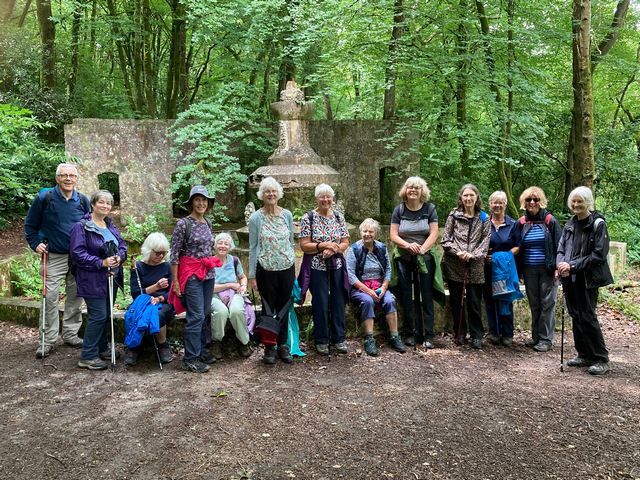
One of our members, Penny who was born, brought up and still lives in Lerryn showed us a black and white photo of one of the two fountains in Tivoli Park taken in its heyday.
I am glad to report that the logistics worked and that there were enough cars left in Lerryn to take people back to their cars in St Veep. What a relief!!!
This was our last walk of the summer months and we will resume our programme on September.
REPORT OF WALK ON 13th JUNE 2023,
4 MILE CIRCULAR ESTATE WALK, LANHYDROCK
It was a gorgeous sunny Cornish day when 14 members of our group met at the main car park at Lanhydrock. Several others were disappointed not to be able to join, because of other commitments.
We set off down the main path towards the old kitchen garden which once provided fruit and veg and plants for the estate. On to the Ford Plantation wood which suffered huge damage in the storm of 1990 but now mature oak, ash and hazel stand as survivors: the Trust now leaves nature to its own resources to recover.
On through Maudlin Wood, past small quarries which once supplied stone for the estate, and Jacob's Quarry named after a former employee in the 1870s.
Continuing on we crossed over the River Fowey by way of Kathleen Bridge and on to Respryn Bridge. (we have been unable to ascertain why it is named Kathleen Bridge. If anyone has the answer we would love to know). 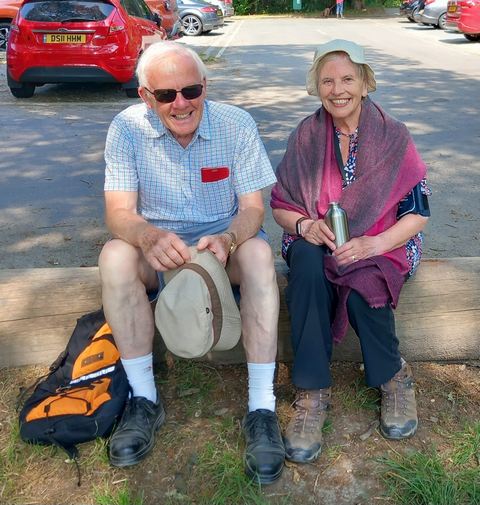
We had a short break here at Respryn, which played a strategic part in the Civil War. In 1642 the bridge was guarded by the Royalists until the Earl of Essex came to Cornwall in 1644 and established his headquarters at Lanhydrock, the home of Parliamentarian John Robartes and seized the bridge. He soon had to abandon it to the enemy and it fell into Royalist hands. Robartes escaped by sea to Plymouth: his children remained as prisoners at Lanhydrock until the Royalists lost the war and he was able to return home.
We continued on to Station Drive, through a couple of red gates and through ancient Hart Wood, into Lodge Plantation with beech, oak and birch trees, round Lanhydrock cricket club and back to the car park.
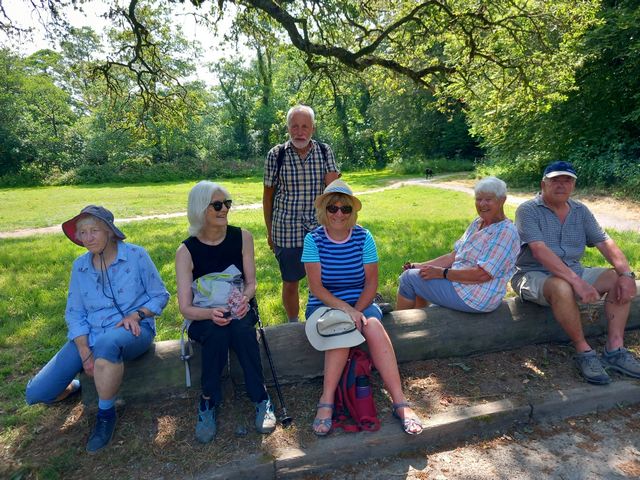
A few members of the group then decided to return to Lostwithiel and rounded off a most enjoyable morning with coffee and cake in the garden at the Community Centre.
REPORT ON WALK OF 30th May 2023
A 5.5 MILES CIRCULAR WALK
FROM TRELISSICK GARDENS TO ROUNDWOOD QUAY
Ten members of the group armed with their NT membership cards met up in the Trelissick gardens car park for, at long last, a walk in beautiful sunny and warm weather.
The setting for this walk reflects the themes echoed throughout the Parish of Feock: the house and the gardens were built largely with the proceeds of mining from its heyday. The gardens were also a product of the age of discovery when the Cornish plant hunters scoured the world for riches, as did their mining cousins. All this is set within a maritime backdrop marrying industrial heritage with modern leisure activities.
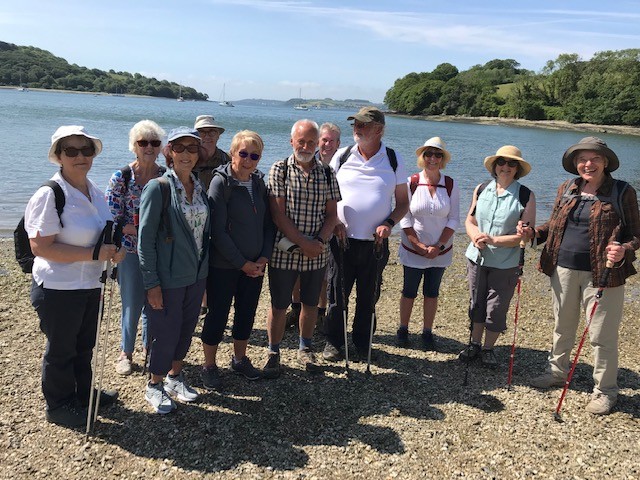
We walked across the cattle grid by the information centre and out into the pasture field to follow one of the routes down towards the estuary that we could see in the distance along with Pendennis Castle. We followed a path above the beach which borders the estuary which took us to the road that you drive down to take the King Harry Ferry to travel to the Roseland Peninsula. The King Harry Ferry was originally powered by oars; however, its importance warranted a better system and in 1889 steam was introduced. It is now a chain ferry and we could clearly hear the clink clonk of the chain as the ferry was crossing the estuary.

We followed the well-maintained woodland track which borders the estuary and at one stage, we could see Roundwood Quay which was our destination for our picnic lunch. However, I had to point out that it would be a while before we reached the quay as we had to walk to the end of Lamouth Creek, walk across a footbridge and then walk back towards the estuary.
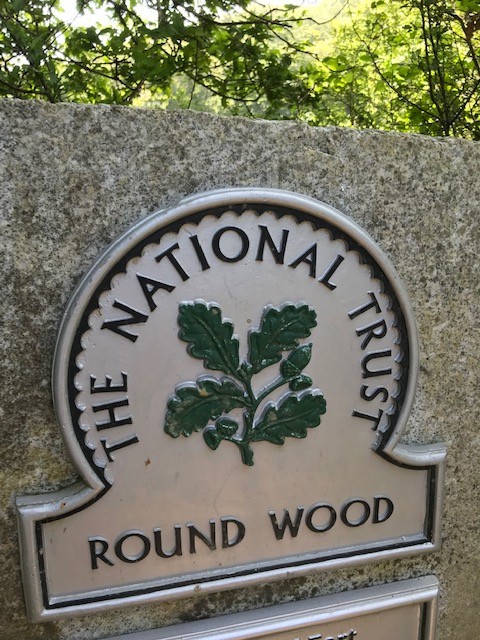 |
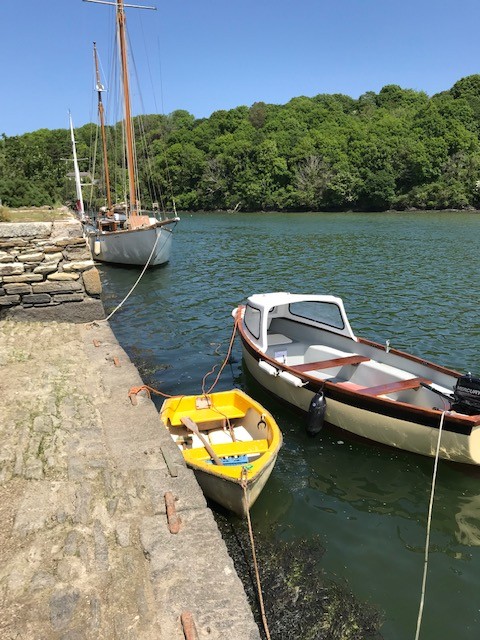 |
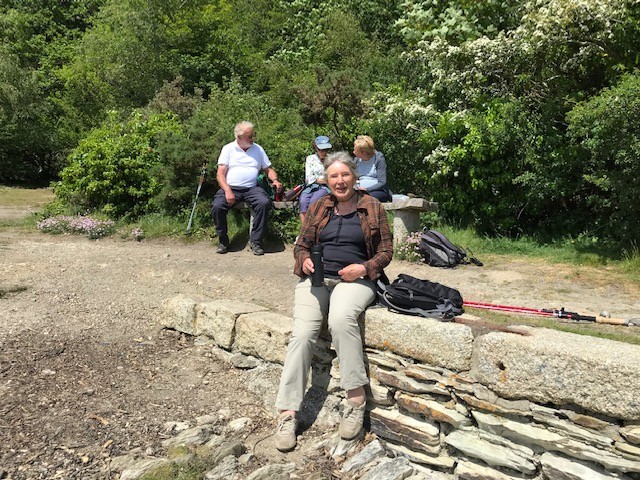 |
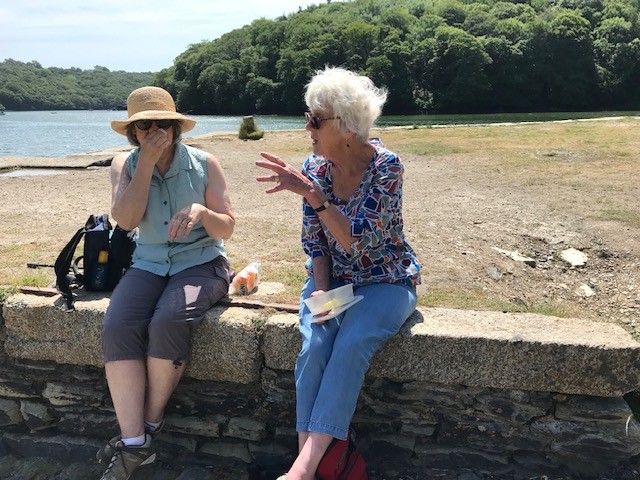 |
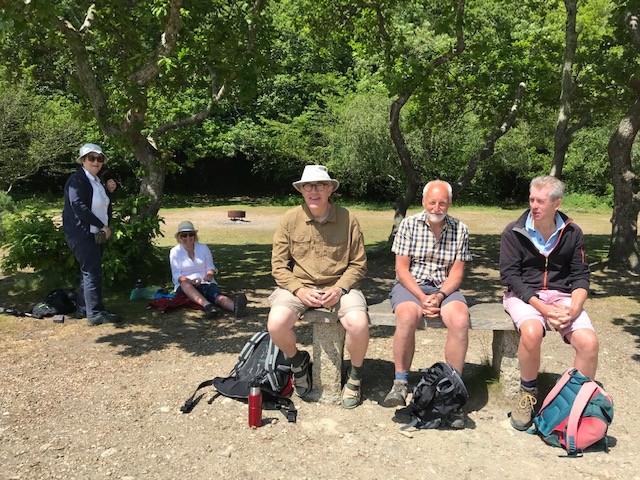 |
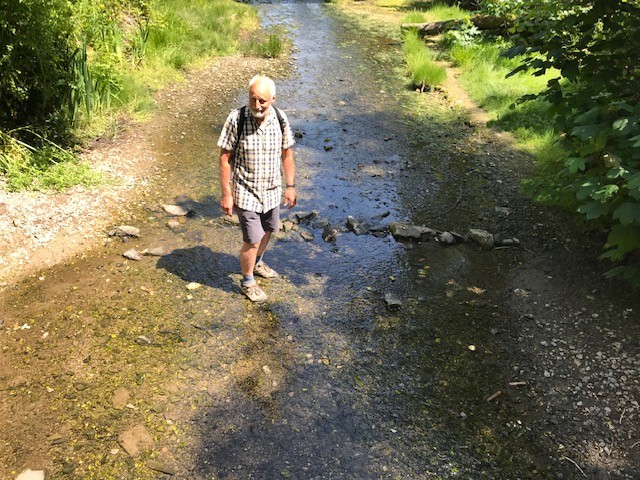 |
The quays at Roundwood were probably built by Thomas Daniell around 1760 and their principal purpose was to service the tin and copper mines of Kea and Gwennap with coal and exported ore. The quay area was also home to a copper smelting operation for a period in the 1770s. From Roundwood Quay, you have a good view of Tolverne and Smugglers’ Cottage – it used to be a hostelry but is now a private residence.
For the second half of the walk, we walked through the Roundwood Quay National Trust car park, up a lane past cottages and through fields from which we saw in the valley below the hamlets of Coombe and Cowlands with their many fruit orchards. This is the home of the famous Kea plum. The area was a hive of activity in the 19th and 20th century when, during harvest time in August and September, it was a magnet for pickers which even came by steamer boat from Truro and other Fal ports to take a share of the bounty.
We then crossed the main Roundwood track and re-joined the Trelissick fields and walked though orchards planted in the last ten years.
We were back on the woodland footpath and made our way back to the footbridge. We then turned right and climbed up the hill back to Trelissick. Not far from the main road, there is a strategically placed bench from which you have good views of the Tregothnan Estate and even the corner of Roundwood Quay. Back in the Trelissick Gardens, we made our way to the cafe for some refreshments.
REPORT ON THE HALL WALK ON TUESDAY 14TH MARCH 2023
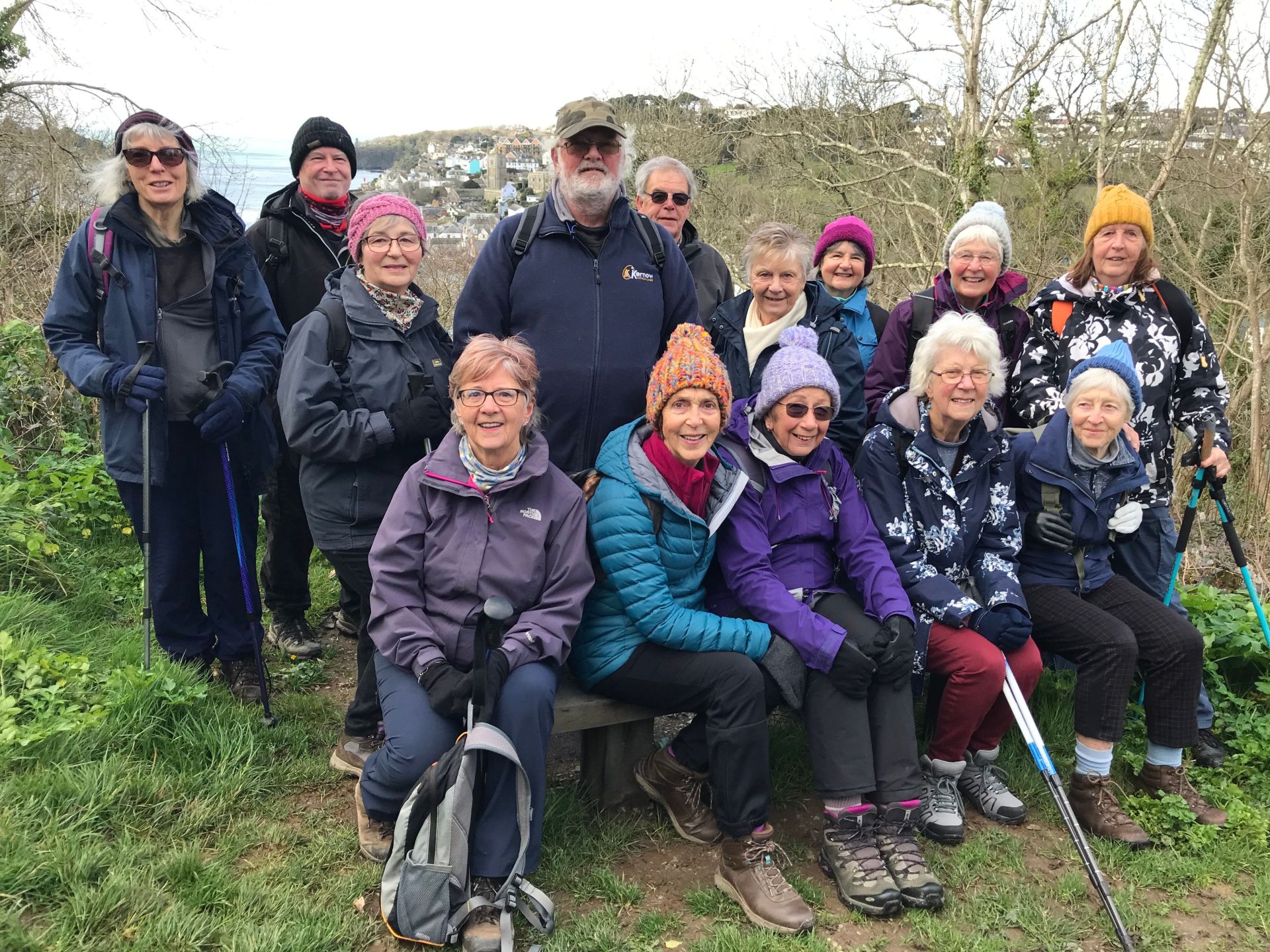
Fourteen members travelled from various locations and met up on the slipway in Bodinnick. We reckon that it is about five years ago that we last did this 3.5 mile walk which takes you from Bodinnick to Polruan (or vice versa of course!). To add to the enjoyment of the walk, it includes two ferry rides: the foot passenger ferry from Polruan to Fowey and the car ferry from Fowey to Bodinnick.
This famous walk between Bodinnick and Polruan offers stunning views over Fowey, the estuary and out to sea. It was originally a promenade for Hall Manor, built just above Bodinnick in the 13th century. The dry and sunny weather ensured that we could make the most of those beautiful views. We met a lot of walkers including holiday makers making the most of the only dry day of the week!

If you have never done this walk, to find the start you walk up the main hill past the Old Ferry Inn and take the path signed "Hall Walk" on the right. The walk is well signed and almost entirely traffic free, mainly via woodland paths. It is a moderate walk with many ups and downs and muddy paths. There are lots of bluebells and wild garlic in the woods in spring. We saw some snowdrops, violets and many primroses.
Leo Walmsley wrote several novels while living by the creek. It is the setting for his autobiographical novel Love in the Sun.
The first leg of the walk took us to Pont Pill for our refreshment break. Pont Pill (Cornish: Pyll Por' Reun, meaning creek of seal cove), joins the River Fowey at Penleath Point just below the memorial to Sir Arthur Quiller-Couch at the north-east corner of Fowey harbour. Pont Pill is a tidal river and is only navigable at high water. Unspoiled by development, Pont Pill is popular with bird watchers, walkers, sailors and sport fishermen. The best way to see Pont Pill is by small boat at high water when it is possible to reach the bridge a mile-and-a-half upriver at Pont (Old Cornish: Pont Pyll, meaning bridge of the creek) the end of the navigable water. On the way to Pont pill, we had a good view of the very modern house with a turf roof built on the site of an isolation hospital and which featured in the first episode of the ITV series Beyond Paradise.
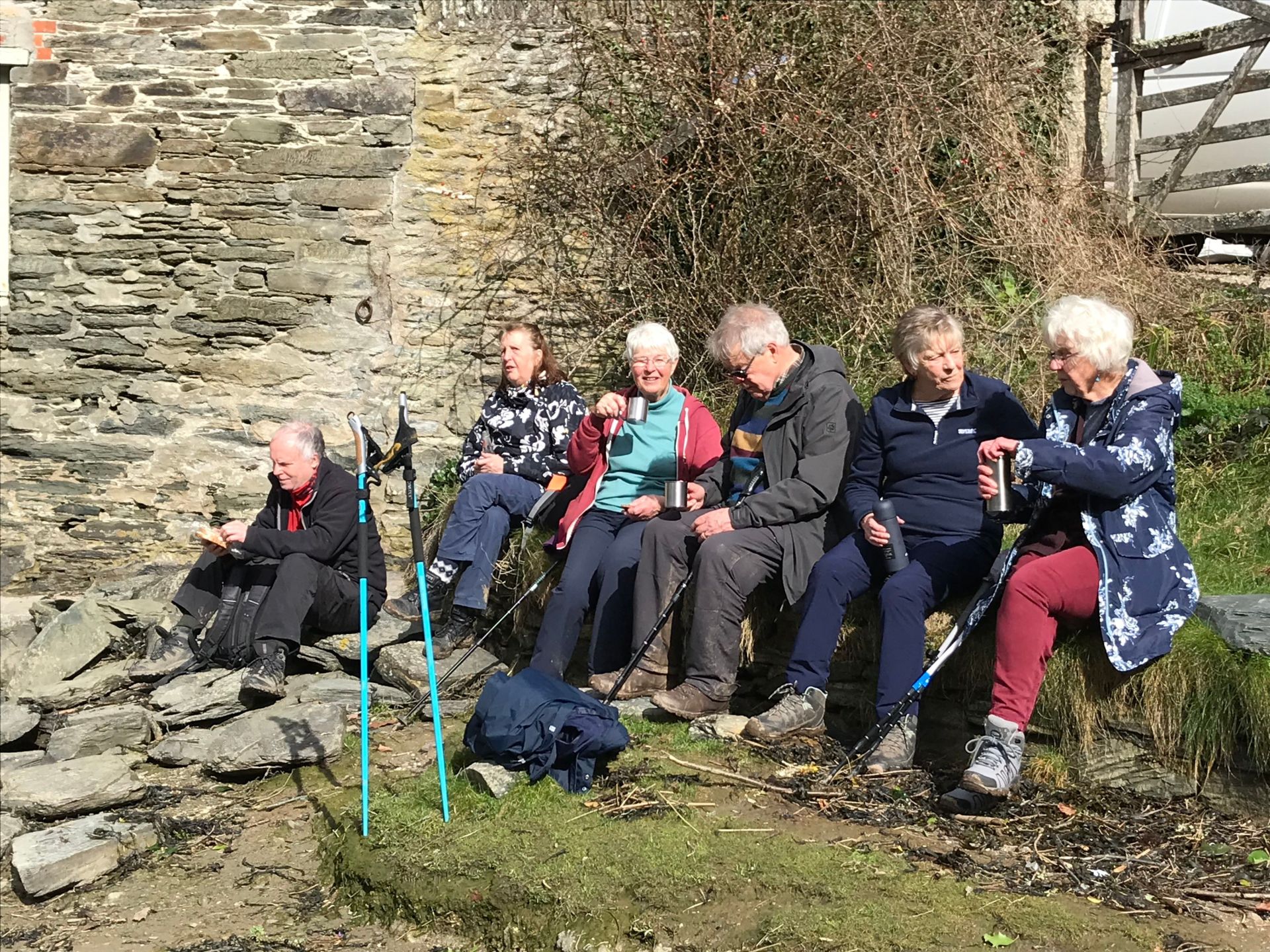
A first for the walking group: during our coffee break, we played Pass the Parcel. This entertainment provided by Anne Fenwick saw Roy win a set of walk cards round England. We look forward to hearing about your travels Roy!

The second half of the walk took us form Pont Pill to Polruan. Once in Polruan, the group members could decide where to have to their lunch and at what time to return home.
Once we had walked back to our cars, we had walked about 4 miles.
Report of walk on 28th February
from Carlyon Bay via Charlestown to Porthpean and return.
On a nice bright but a bit chilly morning 18 of the group departed Carlyon Bay car park at 10:00am for our walk to Porthpean. The walk took us along the costal path from the car park to Charlestown.

We had arranged to meet 3 more members of our group here. On our arrival they were just finishing a cup of coffee sat outside in the sun!! Four of the group who had other commitments later in the day returned to their cars. The walk took us from Charlestown up through Duporth before turning left towards Porthpean. Taking yet another left we headed for a bridleway on the right which took us across the Porthpean golf course. A few golfers were out on the green enjoying the weather. At the end of the track we turned left and headed towards the Church at Porthpean. A few of the group visited the church and one of the couples on the walk informed us that their daughter had been married in this church. Crossing the road we head down a small lane which looked like a private drive. Across the driveway was our kissing gate which lead us up to some wonderful views across the bay and a granite post where I had planned to stop for a coffee break As it was windy and chilly we headed on down to the costal path and continued along to Porthpean Beach where we stopped for an early lunch.
We all managed to sit on one long row of benches looking out over the sea while eating our lunch and watching the seals in the water.
We set off again after lunch heading up a flight of steps (which certainly got the legs working again!), continuing along the rerouted costal path (due to erosion) before reaching the Crinnis Cliff Battery garden.

From here you were rewarded with a wonderful view over Charlestown.

The path into Charlestown takes you round the back of the Pier Hotel which was recently damaged by fire.
Once back in Charlestown a choice of options was given for the final leg of the walk either stay in the harbour for refreshments, making your own way back to car via the costal path or alternatively walk up the footpath up to Beach Road stopping off for coffee at AJ’s before returning to the carpark.
This walk was approx. 6miles.
WALK OF 14TH FEBRUARY 2023
A SHORT WALK ROUIND PENPOL AND ST VEEP
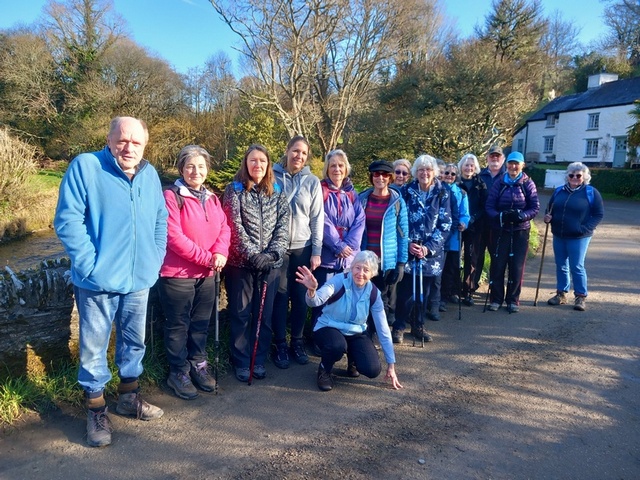
Sixteen members of the group met at St Veep Church for a 3-mile circular walk led by Penny Philp, replacing Annie who was on a St Valentine’s Day surprise outing. It was a beautiful sunny and dry February walk which, albeit short, was full of places of interest and beautiful views of the southeast Cornish countryside.
Penny led the group down to Penpol. As you walk down the hill to the bridge, you see the old forge on the right-hand side. The forge, the cottage and land as far as Myrtle Cottage were sold to the blacksmith, Benjamin Freathy, in 1868 for £55. The bridge looks ancient but was built in 1867.
Like most riverside hamlets, Penpoll (note official spelling) continues to have signs of past trade and business. There is a limekiln and quay, and a mill dominates the area by the bridge. Although long disused, the machinery is intact and is housed in a Grade 2 listed building. In about 1900, the miller here still supplied H.M. Dockyard at Davenport with flour.
The group walked over the bridge, turned left and then immediately left. The walk takes you on a very narrow minor road to Willsland in the Trebant Water valley. The river known as Trebant Water flows into Penpol Creek.
Willsland only has two properties and when you reach them, the road bears left and the sustained uphill re-joins the road which takes you from Lerryn to the road from the Bodinnick Ferry. A phone mast installed in the last seven years ensures that hamlets like Penpol have a mobile signal – quite a bonus.
The group turned left at the mast and then immediately left for another sustained uphill. The views when you reach the brow of the hill are worth the effort. You can see towards the clay mining country and from some field gates, you can even see the obelisk on the Boconnoc estate. The walk takes you past the three Tencreeks – West, Middle and East – peacefully nestling into the hillside. The Tre or Ten prefix to a Cornish name signifies a very ancient homestead site. In the mid-1800s Sarah Best farmed West Tencreek and was one of the parish overseers of the poor. This was the equivalent of today’s Social Services official, and an unusual position for a woman of that time.
Upon reaching Riding Cross, the group turned left and walked back to their cars. There was an opportunity, for those who wanted to, to visit the church which has very unique bells. In the mid-18th century, the unique virgin peal of bells was cast “in the still of the night” and did not have to be tuned. This is why they are called virgin or maiden bells.
WALK ON THE 31st JANUARY 2023
BODMIN AND BODINIEL-THE TWO MANORS
On a day with a positive weather forecast later in the day 18 of us gathered at the Camel Trail car park at Dunmere to walk the advertised 5.2 mile figure of eight walk to the Beacon in Bodmin and back again via Lower Bodiniel.
The first part was on a leafy path parallel and higher up the valley to the Camel Trail before we arrived near the jail and the town roads which lead past Sainsbury supermarket to the Priory car park and Bodmin Football Club.
Uphill then to join Harleigh Road and Beacon Road before turning left and up to the Beacon and a welcome cup of coffee and sit down with the clouds and drizzle starting to drift away. This 44 metre monument was built in 1857 to honour the life of Sir Walter Raleigh Gilbert who was born in Bodmin in 1785.
An ideal place to have a photograph.
Although everyone on the walk had seen the beacon and driven past it quite a few had not been up to structure and were amazed at the view and the space even if it was still was a bit misty and the start again of the drizzle.
Walking now past the beacon and car park and back to Robartes Road we go down the steep hill called Beacon Hill with on the right terraced houses very reminiscent of the Welsh Valleys and a large chapel (which was Weatherspoons) at the bottom. At the main road we passed the Old Library and cross the road to again go down hill with the great views of the jail showing the scale of the building to begin the final part of our figure of eight.
Uphill now past the jail entrance and Armchair Corner to Middle and then Lower Bodiniel and Lower Bodiniel Cottage where we turn right, over the one stile, and onto the well marked footpath.
Treading carefully on the downhill footpath we soon reach the Camel Trail and return to the car park. For ten of us, three of whom had joined us by car, had a good lunch in The Burough Arms before setting off home.
Report of walk on Tuesday 10th January 2023
Par and Tywardreath circular walk, approx. 3.5 miles
It was a bit stop and start because of a dodgy weather forecast but eventually the green light was given and 16 stalwart walkers met at Par Beach car park.
The walkers were warned that it would be muddy and they were not disappointed. The route took us through a wooded area, across the china clay haul road, and around Par Track before skirting Par Station and then round the duck pond, dodging many ducks, swans and geese. 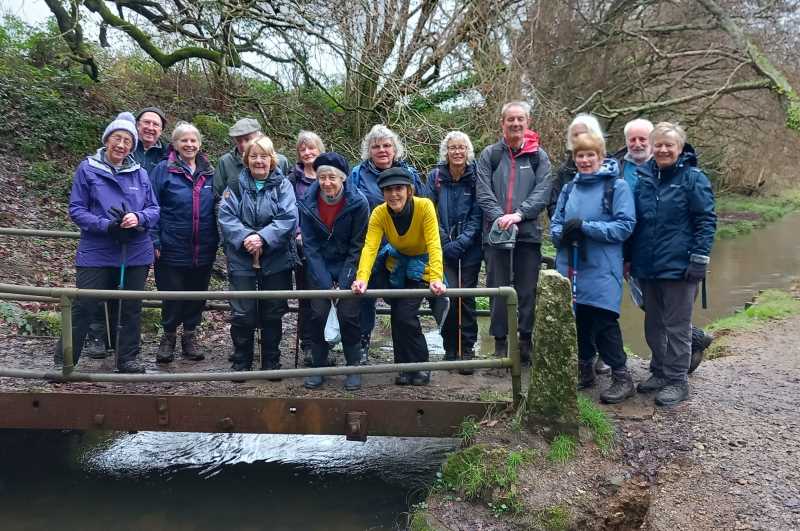
Then it was up through the marshes where the mud and water certainly lived up to its name, bringing us eventually into Tywardreath where we stopped for a photo at the historical St Andrew's Church. Tywardreath means 'House on the Strand' and was immortalised in the book of the name written by Daphne du Maurier in 1969. We tried to lose half the group while they looked around the church but they caught up with us again. 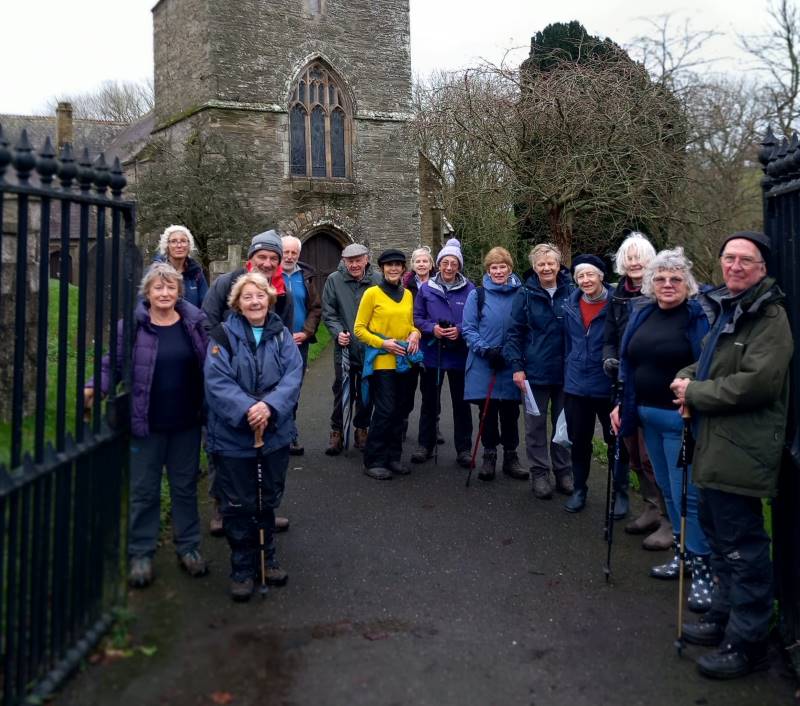
The estuary once flowed almost up to the church's walls and the water is remembered in the church's dedication to St Andrew, a fisherman named by Jesus as a 'fisher of men'.
From there we walked up Well Street back across the main road and back to Par Beach where some of us had a good cup of coffee at the interesting Cognitive Coffee Company steam punk van, open almost every day and well worth a visit at any time.
So we managed to miss the showers which threatened to follow later in the afternoon and completed the first walk of the 2023 season.
**************************************

